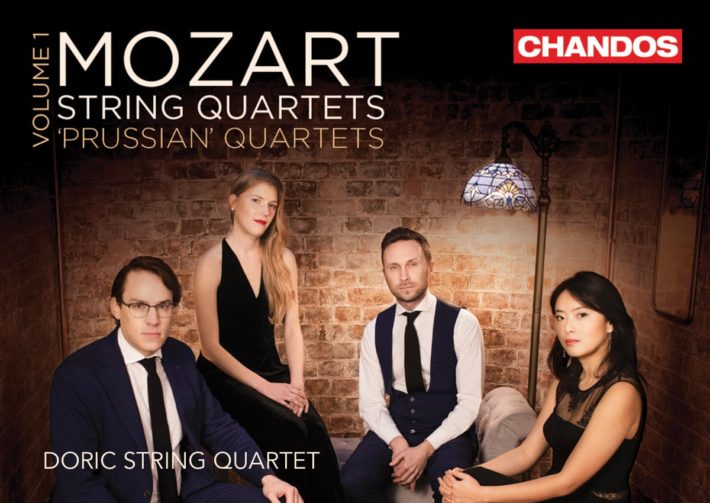The Doric String Quartet is no stranger to ambitious endeavors. Having released an acclaimed fourth volume of the Haydn String Quartets in the latter half of 2020 (reviewed here), the ensemble looks poised to take on a Mozart cycle with its first recording: a presentation of the three Prussian Quartets (1789-1790). Mozart at this time was facing financial difficulties but a fortuitous situation arose when he received a commission from King Friedrich Wilhelm II for a series of string quartets.
As a nod to his patron (who took up the cello), the instrument ceases to be a merely supporting figure, as is evident in the first movement of the String Quartet in D major (Disc 1, Track 1). Yes, it does start off as a rhythmic anchor, but it soon echoes a melodic phrase from the first violin which cements its place in the texture; in other moments, it becomes the lead. Mozart’s quintessentially light and elegant writing is on full display, but what the Doric does especially well is to imbue the movement with nobility and refinement. The music is not meant as a trifling diversion, making a bold statement with surprising sforzandos and assertive lines. But even in the lyrical sections, the performers’ thoughtful phrasing shows the interwoven intricacies of the writing.
The Andante (Disc 1, Track 2) shows another type of intricacy – the ensemble’s high degree of sensitivity. The opening theme is so gentle yet well-integrated and balanced with each voice playing its due role in filling out the harmonies. Throughout the movement, voices often move together, and the group has a flawless synchronicity every time. As a continuing thread from the previous movement, the Andante also features continued dialogue between the first violin and cello: sometimes, the violin starts a phrase and the cello seamlessly picks up where it leaves off. In others, the two move in parallel fashion which brings out the intervallic movement.
Related Classical Music Reviews
- Review: Haydn – String Quartets Op. 33 – Doric String Quartet
- Review: “Joy and Desolation” – Tesla Quartet, Alexander Fiterstein, Clarinet
- Review: “All Shall Not Die” – Haydn String Quartets – Quatuor Hanson
The third (F major) Quartet is another highlight. The performance plays on the element of surprise from the get-go, all while maintaining a lovely tone quality. Compared to the D major, there’s even more activity in the voices that lends to each its own personality. The group demonstrates a clear versatility, becoming just as “individualized” as it can be synchronized. Each instrument gets to present flashes of virtuosity in (excellently articulated) sixteenth note runs; the viola even adds an interesting passage of chromaticism at 1:55. The performance is refreshing and energy-driven which carries a bit into the “slow” movement (Disc 2, Track 2). Although it has the same Andante title as the D major, there’s a lot more going on here in terms of constant interchanges between voices. For all its sprightliness, the performance doesn’t make us feel rushed or frantic. Well-controlled bowing, for instance, gives the staccatos a softer feel, especially in the cello and viola. The violins, meanwhile, approach their lines with clarity but also a soothing mellowness.
The joyful Allegro may be more brisk and perhaps more nervous than, say, the Alban Berg Quartet’s 1976 wonderful version, but it is nonetheless effective. A series of curious whispers soon widens into a full-fledged conversation. The group creates an orchestral effect by highlighting each of the voices, and not just the ones with melodic motifs. Some passages (0’50” onwards is an example) have the perfect blend of drive and power: the cello gives pronounced bass notes a deliberate bounce without overpowering, though a more lingering resonance here might be a nice addition. The second violin and viola, as inner voices, fuel the bustling momentum. And of course, the first violin adds the melodic line that captures the fierceness of the section.
Like their previous Haydn recording, the quartet uses classical bows which give the performances a perceptible agility and airiness. While the louder sections may not have the density we’re necessarily used to, the ensemble more than makes up for it with a well thought-out layering of voices. The liner notes, which provide solid musical analyses, are a fitting complement to the polished interpretations. This album certainly set the bar high for the quartet’s future installments, which I for one undoubtedly look forward to.

Mozart – String Quartets K. 575, 589, 890
Doric String Quartet
Chandos, CD CHAN 20249(2)
Mozart – “Prussian” String Quartets – Recommended Recordings
Read more classical music reviews or visit The Classic Review Amazon store
Follow Us and Comment:
[wd_hustle id=”HustlePostEmbed” type=”embedded”]











